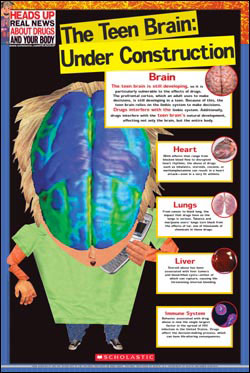
NIDA and Scholastic, Inc., have joined forces to produce a third installment of the series Heads Up: Real News About Drugs and Your Body (Scholastic Web Site). The new science-based articles and vivid, informative graphics will be distributed to nearly 2 million middle and high school students via the pages of Scholastic's publications Junior Scholastic, Science World, and Up Front. This year's materials, which include a teacher's guide, once again strike the theme of the unique dangers drugs pose to teens.
"Research indicates that adolescence, a time when many changes are occurring in the brain, may be a period of significantly increased vulnerability to drugs' effects," says NIDA Director Dr. Nora D. Volkow. By presenting NIDA's research in an accessible format, Heads Up speaks directly to its youthful audience about issues including HIV and drug abuse, the link between food cravings and drug cravings, the health dangers of inhalants, and the misuse of prescription drugs.
Adolescents, AIDS, and Abuse: A Deadly Connection
Between 1998 and 2000, one of every six persons with a newly diagnosed HIV infection was between the ages of 13 and 25. Along with injecting drugs, which 1 in 50 U.S. high school students report having done at least once, drug-influenced bad judgments can lead to infection, and drugs can reduce the 's ability to fight off infection. "Teens, Drug Abuse, and AIDS: The Deadly Connection" provides young people with the statistics and scientific information they need to understand the potential health consequences of their decisions concerning drugs and sexual relationships.
Linking Addictions to Food and Drugs
"Two Teen Health Dangers: Obesity & Drug Addiction" tells readers how NIDA scientists discovered that cravings for food and cravings for drugs have a common biological basis in the brain. Both drug abusers and obese people tend to have lower than average numbers of the brain proteins called dopamine receptors, a deficit that could limit the amount of pleasure they gain from ordinary activities and achievements. Overeating and drug abuse may be attempts to compensate; both stimulate the dopamine system to higher activity levels.
The article leads readers through the specific experiments researchers conducted to find these connections and teaches how to design a scientific experiment and calculate their own mass index. It points out that people can enhance the brain's dopamine activity without overeating or taking drugs by exercising and spending time with friends and family.
Bucking the Trend: Increase in Inhalant and Prescription Drug Abuse
The 2005 University of Michigan Monitoring the Future (MTF) Survey found that the number of U.S. 8th-, 10th-, and 12th-grade students who reported abusing drugs in the past month dropped 19 percent from 2001 to 2005. However, past-year inhalant abuse among eighth-graders increased, and abuse of the prescription drugs oxycodone (OxyContin) and hydrocodone (Vicodin) remained high. "Abuse of Inhalants and Prescription Drugs: Real Dangers for Teens" paints a vivid, realistic picture of these substances' ill effects. Even in an otherwise healthy person, a single session of abusing highly concentrated amounts of certain inhalants can lower oxygen levels enough to cause asphyxiation or disrupt heart rhythms and cause death from cardiac arrest.
Prescription medication abuse can cause both short-term and long-term health problems, from potentially fatal overdose to addiction and long-term brain changes. In addition to exposing the dangers of these substances, the Heads Up article explains how the MTF Survey data were collected and why these data are important in understanding and fighting drug abuse.
All Heads Up materials can be found at http://headsup.scholastic.com/ (Scholastic Web Site).
